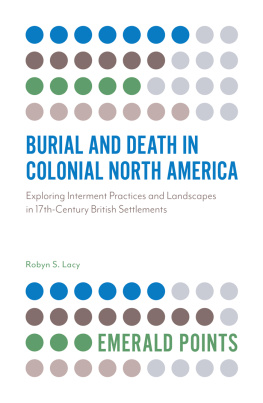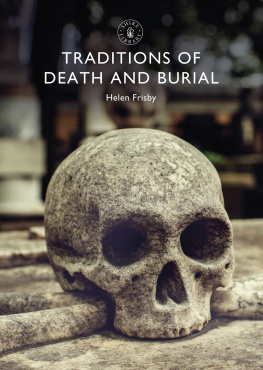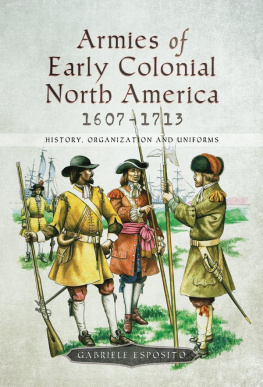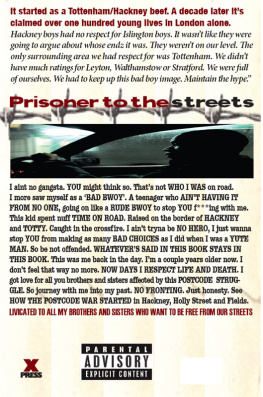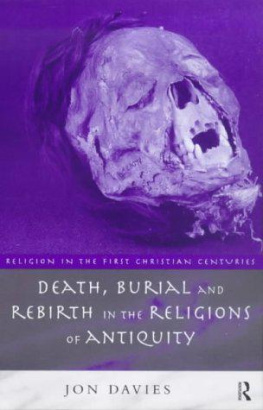BURIAL AND DEATH IN COLONIAL NORTH AMERICA
Exploring Interment Practices and Landscapes in 17th-Century British Settlements
ROBYN S. LACY
United Kingdom North America Japan India
Malaysia China
Emerald Publishing Limited
Howard House, Wagon Lane, Bingley BD16 1WA, UK
First edition 2020
2020 Robyn S. Lacy. Published under exclusive licence by Emerald Publishing Limited.
Reprints and permissions service
Contact:
No part of this book may be reproduced, stored in a retrieval system, transmitted in any form or by any means electronic, mechanical, photocopying, recording or otherwise without either the prior written permission of the publisher or a licence permitting restricted copying issued in the UK by The Copyright Licensing Agency and in the USA by The Copyright Clearance Center. Any opinions expressed in the chapters are those of the authors. Whilst Emerald makes every effort to ensure the quality and accuracy of its content, Emerald makes no representation implied or otherwise, as to the chapters' suitability and application and disclaims any warranties, express or implied, to their use.
British Library Cataloguing in Publication Data
A catalogue record for this book is available from the British Library
ISBN: 978-1-78973-046-3 (Print)
ISBN: 978-1-78973-043-2 (Online)
ISBN: 978-1-78973-045-6 (Epub)
Contents
Acknowledgements
I'd like to extend my thanks to a number of people who helped get this book together and to the presses! Thank you firstly to my publishers and assistant editors at Emerald for checking in and guiding me through the book-writing process and answering all the questions this first-time author had along the way. Thank you to my reviewers for sending comments and contributing to the final form of the manuscript. Thank you to Dr Barry Gaulton for his endless support of my research during my master's degree at Memorial University of Newfoundland, which ultimately turned into this manuscript.
A special thank you to Adam Montgomery, Lorraine Evans and my mom, Barbara Lacy, for reviewing and editing the chapters for me and for providing valuable insight. The largest thank you to my husband and partner, Ian Petty, for making sure I always had tea and for rooting for me. No book is a one-person job, and your support means everything!
1
Introduction
Archaeologists confront death on a regular basis. There is nothing abstract about this statement; it is merely a truth that comes in tandem with a profession that works with the dead and the landscapes, buildings and objects that were left behind. Sometimes archaeologists come face to face with individuals who died centuries ago, and that connection to the dead becomes much more direct. Archaeologists facilitate discussions of mortality, death and burial, whether it be through museum displays, writing, online discussion, lectures or tours of active archaeological sites. It is important for the field to engage with the topic, as a collective of professionals who can offer a platform for discussion with the public. It is valuable for our understanding of human history and of relationships within societies between the living and the dead to understand the death and burial practices of a group of people. Through this, we are able to construct a better picture both of a society's general and more specific relationships with mortality, how they felt about the bodies of their dead, interactions with funeral practices and how they dealt with the grieving process. An aspect of the funeral and burial practices in any community is where the dead are actually buried with relation to the living, what or which landscape is oriented for the dead as well as the living, within the community of the living. A little-known aspect of death and burial during the North American colonial period is the early seventeenth-century practices from the British Empire who founded settlements along the east coast of the continent. This is due to the lack of gravestones and often of written documentation to highlight those early uses of a space as a colonial burial ground. This book seeks to shed light on those spaces, how they were used and what they meant to their communities.
This book aims to achieve two primary goals: to look critically at seventeenth-century burial landscapes and their organization at North American settlements and to reflect on the settler relationship with mortality. Reflections of mortality and settlers' relationships with their dead are represented in the burial spaces they left behind in the seventeenth century, and in the organization of these spaces that were influenced by sociopolitical, religious and geographic factors. Turmoil in the British Isles between the beginning of the Protestant Revolution in the mid-sixteenth century through the English Civil War in the mid-seventeenth century shaped not only the religious and political landscape of much of the British Isles but also affected the burial landscape of colonial North America. Changes to funerary and burial practices from the earlymid sixteenth century were caused by disagreements between the Catholic Church and the newly ordained Protestant Church of England, whose attempts to remove aspects of medieval Christianity altered church practices and burial rites. The effects of the Reformation on burial practices in the British Isles will be discussed further in Chapter 2. Settlers who died in North America during the seventeenth century did not have the infrastructure for burials found in the British Isles or the patterns of previous burials or structures to dictate where the dead could be buried, but they did have the influence of both old and new burial traditions to guide them.
This book will provide further understanding of the choices and elements that affected the development of the burial grounds and interments within the landscape of British colonial settlements in seventeenth-century eastern North America. While this period is widely studied by archaeologists, historians and genealogists alike, a large-scale study of death and dying in this period which explores aspects of the burial practices, organization and morbid spaces of colonial British settlements had yet to be compiled. The following chapters explore and clarify seventeenth-century burial practices in terms of funerals and burial practices, and burial ground organization by examining both the orientation of graves within these sites and the wider landscape of burial grounds within their associated settlements. Within these burial sites, gravestone-carving traditions as they developed will be explored, as well as folk traditions transferred from the British Isles west to North America.
The data collected during this project provides a unique spatial database for burial ground organization at a regional, coastal and international level. By comparing the results of the frequency analysis, these data provide evidence of trends in burial locations. This information can then be applied to understand the burial practices of newly installed settler communities and also aid in locating seventeenth-century burial grounds that exist in the historic record but of which no clear physical evidence remains.




